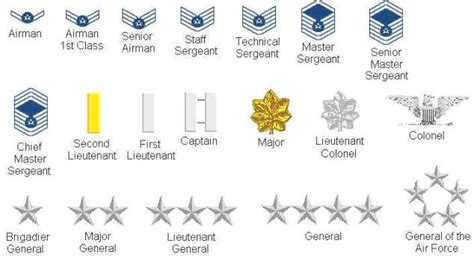Us Air Force Officer Ranks: Guide To Types And Definitions

The United States Air Force is a branch of the United States Armed Forces that specializes in aerial warfare. The Air Force has a strict hierarchy of officer ranks, each with its own set of responsibilities. In this guide, we will take a closer look at the different types and definitions of US Air Force officer ranks.
Overview of US Air Force Officer Ranks
The US Air Force officer ranks are divided into three categories: company grade, field grade, and general officers. Each category has a different set of ranks and responsibilities.
Company Grade Officer Ranks
Company grade officer ranks are typically held by junior officers who are still learning their craft. These officers are responsible for leading small units and ensuring that the mission is accomplished. The company grade officer ranks are:
- Second Lieutenant (2nd Lt) – This is the lowest rank for commissioned officers in the Air Force. Officers at this rank are typically fresh out of the Air Force Academy or Officer Training School.
- First Lieutenant (1st Lt) – Officers at this rank have more experience than 2nd Lts and may be in charge of larger units or sections.
- Captain (Capt) – Captains are the highest-ranking company grade officers. They are responsible for leading larger units and ensuring that the mission is accomplished.
Field Grade Officer Ranks
Field grade officers are typically mid-career officers who have more experience than company grade officers. They are responsible for leading larger units and may have staff positions at higher headquarters. The field grade officer ranks are:
- Major (Maj) – Majors are typically in charge of smaller units or sections.
- Lieutenant Colonel (Lt Col) – Lt Cols are responsible for leading larger units or staff positions at higher headquarters.
- Colonel (Col) – Colonels are senior field grade officers who are responsible for leading large units or staff positions at higher headquarters.
General Officer Ranks
General officers are the highest-ranking officers in the Air Force. They are responsible for leading large units or staff positions at the highest levels of the military. The general officer ranks are:
- Brigadier General (Brig Gen) – Brigadier generals are typically in charge of a major command or higher headquarters.
- Major General (Maj Gen) – Majors generals are typically in charge of a division or higher headquarters.
- Lieutenant General (Lt Gen) – Lieutenant generals are typically in charge of a major command or higher headquarters.
- General (Gen) – Generals are the highest-ranking officers in the Air Force and are responsible for leading large units or staff positions at the highest levels of the military.
What Are the Different Responsibilities of Air Force Officer Ranks?
Each Air Force officer rank has its own set of responsibilities and duties. Here are the different responsibilities of each rank:
Second Lieutenant (2nd Lt)
- Responsible for overseeing the work of enlisted airmen
- Learns how to lead small units
- Responsible for ensuring that the mission is accomplished
First Lieutenant (1st Lt)
- Responsible for leading larger units or sections
- May be in charge of training programs or equipment maintenance
- Responsible for ensuring that the mission is accomplished
Captain (Capt)
- Responsible for leading larger units
- May be in charge of a flight or squadron
- Responsible for ensuring that the mission is accomplished
Major (Maj)
- Responsible for leading smaller units or sections
- May be in charge of a flight or squadron
- May have staff positions at higher headquarters
Lieutenant Colonel (Lt Col)
- Responsible for leading larger units or staff positions at higher headquarters
- May have command of a squadron or group
- Responsible for ensuring that the mission is accomplished
Colonel (Col)
- Responsible for leading large units or staff positions at higher headquarters
- May have command of a wing or group
- Responsible for ensuring that the mission is accomplished
Brigadier General (Brig Gen)
- Responsible for leading a major command or higher headquarters
- May have staff positions at the highest levels of the military
- Responsible for ensuring that the mission is accomplished
Major General (Maj Gen)
- Responsible for leading a division or higher headquarters
- May have staff positions at the highest levels of the military
- Responsible for ensuring that the mission is accomplished
Lieutenant General (Lt Gen)
- Responsible for leading a major command or higher headquarters
- May have staff positions at the highest levels of the military
- Responsible for ensuring that the mission is accomplished
General (Gen)
- Responsible for leading large units or staff positions at the highest levels of the military
- May have the responsibility of leading the entire Air Force
- Responsible for ensuring that the mission is accomplished
FAQs About US Air Force Officer Ranks
What Is the Difference Between an Enlisted Airman and an Officer?
An enlisted airman is a member of the Air Force who has not been commissioned as an officer. Enlisted airmen typically have less experience and are responsible for carrying out the orders of their officers. Officers, on the other hand, are commissioned by the President of the United States and are responsible for leading their units and ensuring that the mission is accomplished.
How Do You Become an Air Force Officer?
There are several paths to becoming an Air Force officer. You can attend the United States Air Force Academy, join the Air Force Reserve Officer Training Corps (ROTC) while in college, or attend Officer Training School (OTS) after earning a bachelor’s degree.
What Are the Benefits of Being an Air Force Officer?
There are several benefits to being an Air Force officer, including competitive pay, comprehensive health care, educational opportunities, and retirement benefits.
